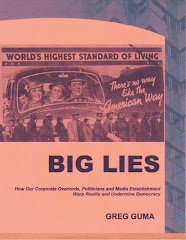 WHY LOCKHEED LIKES VERMONT
WHY LOCKHEED LIKES VERMONT
Part One – Bernie Sanders’ Sandia Epiphany: Here’s Senator Bernie Sanders in 2009 talking about Lockheed Martin, the biggest defense contractor in the world. Lockheed and other top military contractors were guilty of what Bernie called “systemic, illegal, and fraudulent behavior, while receiving hundreds and hundreds of billions of dollars of taxpayer money.”
Among other crimes, Sanders mentioned how Lockheed had defrauded the government by fraudulently inflating the cost of several Air Force contracts, lied about the costs when negotiating contracts for the repairs on US warships, and submitted false invoices for payment on a multi-billion dollar contract connected to the Titan IV space launch vehicle program.
A month later, however, he was in a different frame of mind when he hosted a delegation from Sandia National Laboratories. Sandia is managed for the Department of Energy (DoE) by Sandia Inc., a wholly-owned Lockheed subsidiary. At Sanders’ invitation, a delegation from Sandia was in Vermont to talk partnership and scout locations for a satellite lab. He had been working on the idea since 2008 when he visited Sandia headquarters in New Mexico.
In January 2010 he took the next major step – organizing a delegation of Vermonters. The group included Green Mountain Power CEO Mary Powell; Domenico Grasso, vice president for research at the University of Vermont; David Blittersdorf, co-founder of NRG Systems and CEO of Earth Turbines; and Scott Johnston, CEO of the Vermont Energy Investment Corporation, which runs Efficiency Vermont.
Despite concerns about Lockheed’s bad corporate behavior Sanders apparently didn’t think that inviting a subsidiary to Burlington meant helping them to get away with anything. Rather, he envisioned Vermont transformed “into a real-world lab for the entire nation” through a partnership. “We're at the beginning of something that could be of extraordinary significance to Vermont and the rest of the country,” he said.
More on Lockheed and Vermont later. This is Maverick Media’s Rebel News Round Up,* broadcast live at approximately 11:30 a.m. Friday on WOMM (105.9-FM/LP – The Radiator) in Burlington.
The Question this week: Is the empire collapsing? Then, the Arizona shootings and extreme speech, Digital ID plans, Tom Delay gets easy time, Aerial accidents on Broadway, Unraveling Lockheed’s Burlington plans, plus the rumor of the week.
Live Stream: http://www.theradiator.org/drupal/webcam.html
Call-in: (802) 861-9666
IS THE EMPIRE COLLAPSING?
About 103,000 new US jobs were reportedly created in December. That sounds promising, but it’s not enough to keep pace even with population growth. As a result, the official unemployment rate fell from 9.8 to 9.4 percent. But what really fell wasn’t the number of unemployed people but the number who are actively looking for work.
People who get discouraged and stop looking aren’t considered part of the work force by most statisticians. Therefore they aren’t counted as unemployed. So, the unemployment rate actually fell because the number of discouraged workers increased, not because employment rose.
The unemployment rate for short-term discouraged workers is actually 16.7 percent. When statistician John Williams (shadowstats.com) adds the long-term discouraged, US unemployment as of December goes to 22.4 percent. In other words, more than a fifth of the population.
And what are those 103,000 new jobs? Mainly domestic service work – waitresses and bar tenders, health care workers, and staffers in the retail and wholesale trade.The US has only 11 million manufacturing jobs left. That’s less than 9 percent of the total workforce. Despite the country’s heavy dependence on foreign manufacturing and creditors, the experts in Washington claim the US is still an economic superpower. But the reality is that US corporations have taken too many jobs offshore. That’s big business patriotism.
Last Friday Federal Reserve chairman Ben Bernanke testified before the Senate Budget Committee. He warned that the government must get its budget deficit under control or “the economic and financial effects would be severe.” But how do you get the budget under control when the government, regardless of party or president, is committed to basically running the world? The Congress has just passed the largest military budget in history, and there is no indication that any of America’s wars and occupations are near an end.
The financial crisis isn’t over either. More foreclosures and financial sector troubles loom ahead, which will probably lead to more bailouts for those “too big to fail.” The dollar is also in danger. And the Republican prescription? Cut into Social Security and Medicare to pay for the wars and bailouts.
So, the question for this week is: Is the empire collapsing? Even if there is a modest recovery, are its days as the leading economic power in the world winding down?
NATIONAL SCENE
HATEFUL SPEECH AND VIOLENCE
Back in October, when I returned to radio, my first question of the week was whether extreme ideas and speech led to violent acts, and if those who spread hateful ideas are responsible when someone follows through.
Now we have the shooting spree in Tucson, in which six people including a child were killed, and 14 people were injured, including Congresswoman Gabrielle Giffords. The relationship between hateful speech and such attacks hasn’t been resolved – but the shootings have put the topic at the center of public attention and debate.
What happened in Arizona wasn’t an isolated incident. It was the culmination of a series of threats and attacks, most in response to Rep. Giffords’ support for health care reform. In November 2009, a visitor brandished a handgun during a "Congress on your Corner" event at a local Safeway. On March 22, 2010, just hours after Giffords cast her vote in favor of health care reform, a vandal jumped a gate and smashed the glass front door of her Arizona office. A few days later the now infamous map featuring Giffords' district in the crosshairs was posted by Sarah Palin's PAC. In announcing the map, Palin issued a tweet urging her supporters "Don't retreat. Instead — reload!” This week, through a spokesperson, Palin denied that the crosshairs targeting 20 Democrats who voted against health care reform represents gun sights. They were really surveyor’s markings. Right.
During last fall’s campaign season, Jesse Kelley, Giffords' Republican opponent, held an event in which he asked supporters to donate $50 in order to "shoot a fully automatic M16" to "get on target" and help "remove Gabrielle Giffords." Palin praised Kelly on Fox Business News, saying "I don't feel worthy to lace his combat boots."
Givern all that, should we be surprised about what happened?
ARIZONA CIRCLES THE WAGONS
How is Arizona processing its grief over the tragedy. I don’t want to over-simplify, but the legislature is debating whether to allow concealed weapons in colleges and universities. It’s beginning to look like the take away is “arm everyone.”
Even more telling is a new law designed to keep protestors away from the funerals of the six victims. Legislators from both parties want to make it illegal before the weekend to picket within 300 feet of any home, cemetery, funeral home or house of worship before, during or immediately after a ceremony or burial.
House Speaker Kirk Adams, a Republican from Mesa, has conceded that introducing, debating and approving such legislation so fast is "unprecedented.'' But that isn’t stopping them. An aide to Gov. Jan Brewer says she’ll sign the measure as soon as it reaches her desk.
WIKILEAKS AND DIGITAL IDS
Last week, if you recall, the rumor of the week was the idea that the Wikileaks controversy was a CIA conspiracy designed to crack down on the Internet. While that’s clearly a stretch, there is evidence that the government is using the situation to take some long-anticipated steps.
Case in point: White House officials say that President Obama plans to give the US Commerce Department authority over a plan to create an Internet ID. White House Cybersecurity Coordinator Howard Schmidt calls Commerce "the absolute perfect spot in the US government" to centralize efforts toward creating an "identity ecosystem." Civil libertarians can at least take solace in the fact that Commerce beat out the National Security Agency and the Department of Homeland Security. Now that would be scary.
The administration is currently drafting what it calls the National Strategy for Trusted Identities in Cyberspace. "We are not talking about a national ID card," says Commerce Secretary Gary Locke. "We are not talking about a government-controlled system. What we are talking about is enhancing online security and privacy, and reducing and perhaps even eliminating the need to memorize a dozen passwords, through creation and use of more trusted digital identities." I must admit, the password idea does sound attractive.
Details are scarce. There might be a smart card or a digital certificate that proves online users are who they say they are. Digital IDs could be offered to consumers by online vendors for activities like financial transactions. But anonymity may still be possible and the ID itself will probably be created by private companies. Feel better?
TOM DELAY GETS OFF EASY
The crimes of former Congressional strongman Tom DeLay clearly merit hard time. Among other things, he rigged redistricting in Texas and funneled illegal corporate money into elections. In the resulting court case, he faced up to 99 years behind bars for money laundering, and another 20 for engaging in a criminal conspiracy.
The specific crime that led to his conviction involved the use political action committee to move $190,000 in corporate campaign contributions to the Republican National Committee. Now that Citizens United has opened the corporate floodgates for campaigns, such tactics may no longer be necessary. In the Delay case, the RNC distributed money to Republican legislative candidates in Texas. Those elections shifted state House control to the GOP. Then, at DeLay's behest, legislators redrew Congressional district lines in a way that favored Republican candidates so much that five Democratic incumbents were defeated in the 2004 election.
The defeated Democrats had survived the Republican sweep in 2002. Yet, in 2004, a better year for most Democrats, they lost. It wasn’t just shifting voter sentiment. The defeats were caused by DeLay’s subversion of the 2002 elections and the redistricting process. Unrepentant in court, he explained: "I fought the fight. I ran the race. I kept the faith."
And, in the end he got off easy. The former congressman was sentenced last Monday to three years in jail and ten years probation. Still, DeLay refuses to admit he did anything wrong. His attorneys are appealing the sentence.
AERIAL ATTRACTION
In New York theater circles the big story is Julie Taymor’s Spider-Man: Turn Off the Dark. It’s the most expensive Broadway musical ever staged -- $65 million. Also the most dangerous. Last October an actor broke both wrists when he was catapulted across the stage. Another broke a toe. During the previews, a lead actress got a concussion when she was hit by a rope. A month ago someone fell off a 30-foot platform, fracturing his skull and breaking four ribs. He just got out of rehab.
Meanwhile, ticket sales have soared. Is it the music or the possibility of witnessing an aerial accident?
LOCKHEED & VERMONT
Part Two – A New Business “Partner”: Burlington Mayor Bob Kiss evidently reached a similar conclusion to Bernie Sanders last November when he signed a letter of cooperation with Lockheed Martin. The plan is to work together on sustainable energy projects. Burlington is the first city in the country to develop such a partnership. Similar to Sanders, Kiss says working with Lockheed will help Vermont remain a leader in addressing energy issues and climate change. Its military work and record of corporate crimes aren’t factors for him.
When I asked Kiss at a Neighborhood Planning Assembly last week whether the plans for the Burlington-Lockheed partnership and a Sandia satellite lab were related, he described the corporation’s offer as “serendipitous.” In short, it is just good fortune, a lucky coincidence, that Lockheed wants to work with Burlington, Sandia is creating a lab here, and Lockheed's F-35 may be stationed a few miles away at the airport.
It was a bit hard to accept. One reason is that the details of both deals were worked out at about the same time and sounded eerily complimentary. During a two-day field trip in early November, just before Kiss announced the Lockheed partnership, Sandia officials again met with Bernie at his office, this time to discuss specific areas for collaborations.
Sanders painted a rosy picture. Businesses, ratepayers and researchers will get a boost. A $1 million DoE planning grant is already in hand and more support from the Department of Energy will arrive as the project gains steam. Sandia Vice President Richard Stulen has confirmed Bernie’s pledge that no weapons development work would be involved. The focus, he promises, would be cutting edge research on cyber security, specifically a “smart grid” that can stop hackers.
Sandia sees Vermont’s energy infrastructure as an “ideal place” to create a model for the rest of the country. The Department of Energy is reportedly impressed with work underway in the state on forward-looking renewable energy technology, as well as a willingness to “tinker with related policies and regulations.” True to the Lockheed playbook, Sandia defines the lab’s mission as energy “security.” But the big carrot is the prospect of not only some jobs but a chance for Vermont businesses to get a “global competitive edge.”
The letter of cooperation between the city and Lockheed backs up this argument. Lockheed Martin Corporation Senior Vice President and Chief Technology Officer Dr. Ray O. Johnson has stressed national security and “the economic and strategic challenges posed by our dependence on foreign oil and the potential destabilizing effects of climate change.” The Burlington partnership, he says, will “demonstrate a model for sustainability that can be replicated across the nation."
It’s surely tempting to be a “model” for the nation, not to mention being offered enough money and technical expertise to help make it happen. But such a generous offer also opens up new lines of inquiry, like who exactly is making the offer, why here and now, and whether this eager partner can be trusted.
A related issue is whether it will be more difficult, or even possible, to say no to hosting Lockheed’s big ticket military project – the F-35 – if a close partnership with the corporation and its research lab is in place with the backing of Burlington’s Mayor and the entire Congressional delegation.
Part Three – A Flying Brick in the Green Mountains? For the past decade the F-35 Joint Strike Fighter has been Lockheed’s largest project. It’s also the largest project in the history of military aviation. As William Hartung explains in Prophets of War, winning the contract preserved Lockheed’s role as the leading producer of combat aircraft.
At first everyone wanted in – the US Air Force, Navy and Marines, the Royal Air Force and Navy, and seven other countries, Having so many buyers and partners was supposed to keep the unit cost down. But as the R & D proceeded, various capabilities and requests collided. The Defense Advanced Research Projects Agency (DARPA) added technical bells and whistles, hoping to produce a plane that could be used for not only for air-to-air fighting but also for air support and stealth missions. In other words, it was supposed to address the needs of three different military services and several foreign countries.
Lockheed’s problems with the plane came to a head in early 2010, only months after Defense Secretary Robert Gates proclaimed it a viable alternative to building more F-22 Raptors. Only 16 of 168 proposed test flights had been completed, and cost overruns were driving up the price as it became the costliest weapons program in Pentagon procurement history.
Last February South Burlington City Council Chair Mark Boucher sent a letter to the Air Force about the prospect that F-35s might be stationed at Burlington International Airport. Beyond expressing disappointment that the city wasn’t receiving enough notice about meetings, he wanted the military to know that many locals had problems with “bedding” the plane near them. Quite a few homes have already been torn down to make way for airport expansion. “Every home the airport acquires is one less available for a new working family in our City,” Boucher wrote.
There is also concern about the impacts of noise, light and other pollutants, and an increase in traffic as more military personnel arrive. At the very least, the city wants to see and hear an operational plane “so residents can judge the noise at landing and take-off,” hear the pitch of the engines, and see how it compares with the F-16.
The Air Guard responded by holding a public briefing for local leaders in April. Hundreds of residents showed up, many of them concerned about the plan. Sheryl Parker, coordinator of the fed’s Environmental Impact Study, was polite and seemed to say that lack of community support could be a factor in the final decision. But when asked if that meant fighters wouldn’t be based in South Burlington if enough people objected, she replied, "I wouldn't say that."
As it turned out, before the impact statement could be issued Senator Pat Leahy – who takes pride in bringing as much military money to Vermont as possible -- jumped the gun in November with what he considered good news. Without offering any specific reasons he announced that the airport had advanced to a two-member “short list” for the plane.
Congressman Peter Welch touted the Vermont Air Guard’s reputation, Leahy promised that the plane’s noise could be minimized, and Sanders saw the announcement as a “sign of the great national respect and admiration” for the Guard. But for F-35 critics like Juliet Buck, who has tracked the issue for months, the announcement meant something else. It had turned the environmental impact study into a pointless “dog and pony show.”
Funding is another matter. As Congress reconvened last week Defense Secretary Gates continued to insist that, despite years of delay and massive cost increases, the F-35 remains the “heart of the future of tactical combat.” But that didn’t stop him from putting forward a spending plan that includes cuts in the number of planes – “restructuring” in Pentagon-speak – to compensate for all the delays.
Ordering fewer planes doesn’t mean that the Pentagon is reconsidering anything, only that the cost of each will be even higher. Various military branches remain wedded to the plane, whatever the cost. As CBS put it in a December 2010 report, the F-35 is apparently “too big to fail.” Lockheed clearly sees it that way.
RUMOR OF THE WEEK:
BLACKBIRD DEATHS LINKED TO PHOSGENE – AND MURDER
Remember those red-wing blackbirds that died in Arkansas on New Year’s Day? Well, here’s a possible explanation – an Air Force KC-767 tanker aircraft transporting Phosgene poisonous gas to Afghanistan that malfunctioned shortly after takeoff from Little Rock Air Force Base.
The charge supposedly came in a report by Russia’s Foreign Military Intelligence Directorate. The story begins at the Pine Bluff Arsenal, also known as “America’s Arsenal,” a base that specializes in chemical-biological defense. In the past, Russia has accused the US of removing chemical agents from Iraq and taking them there for testing and, hopefully, destruction.
The US reportedly relocated an estimated 63,000 metric tons of the poisonous gas Phosgene from Iraq to Pine Bluff between 2003 and 2008. Phosgene is one of the most dangerous chemical weapons ever used. It can literally cause the lungs and respiratory system to explode.
Last September, the government began “accelerated” disposal of the gas by injecting it into the ground in central Arkansas, the Russians claim. Unfortunately, this caused hundreds of small earthquakes. Then the government decided to ship part of the stockpile – the Russians say “massive quantities” – to Afghanistan. Why? Apparently because this poison gas can no longer be legally manufactured by the US. And that makes it valuable as a Weapon of Mass Destruction, especially in a situation where the enemy is firmly entrenched in hostile terrain.
After the aerial release the dead birds were quickly removed by US Environmental Services workers wearing hazmat suits and gas masks. A US report says that cause of death was “trauma in the breast tissue, with blood clots in the body cavity and a lot of internal bleeding.” This is consistent with Phosgene exposure. It was actually the second “accidental” release of Phosgene in as many days. The day before, the same Air Force tanker allegedly had another “critical malfunction,” causing a release over the Arkansas River that killed over 100,000 fish.
What happened next, the Russian report allegedly says, was a murder to cover it all up. The victim was John P. Wheeler III, Special Assistant to the Secretary of the Air Force during the second Bush administration, and more recently Special Assistant for Air Force Installations, Logistics and Environment. Wheeler was brutally murdered and dumped in a landfill sometime last week. Delaware police are investigating.
The Wilmington News Journal reports that Wheeler was last seen riding an Amtrak train from Washington to Wilmington. According to Fox News, somebody initially reported that the body was dumped out of a refuse truck. Newark Police told Fox that nobody reported Wheeler missing before he was found.
Wheeler wrote one of the most important manuals on the effectiveness of biological and chemical weapons. In 2009 he was hired as a consultant to the Mitre Corporation. Its aviation development department creates computer systems used by the Air Force on aerial spraying planes. According to the Russian report, when Wheeler discovered what was happening with the Phosgene stockpiles, he went to Washington and threatened to expose the officials responsible. As a Vietnam Veteran he knew about US chemical and biological attacks in that conflict and had vowed to not let happen again.
His mistake, at least if you believe the rumor, was threatening to go public.
It’s week 524, 3668 days since the country was taken hostage. This is Greg Guma with the Rebel News Round Up on The Rose Show. January 14, 2011 on WOMM-LP. From Burlington in the People’s Republic of Vermont.
*This is an edited transcript and does not include extemporaneous comments and last minute changes or additons.































No comments:
Post a Comment